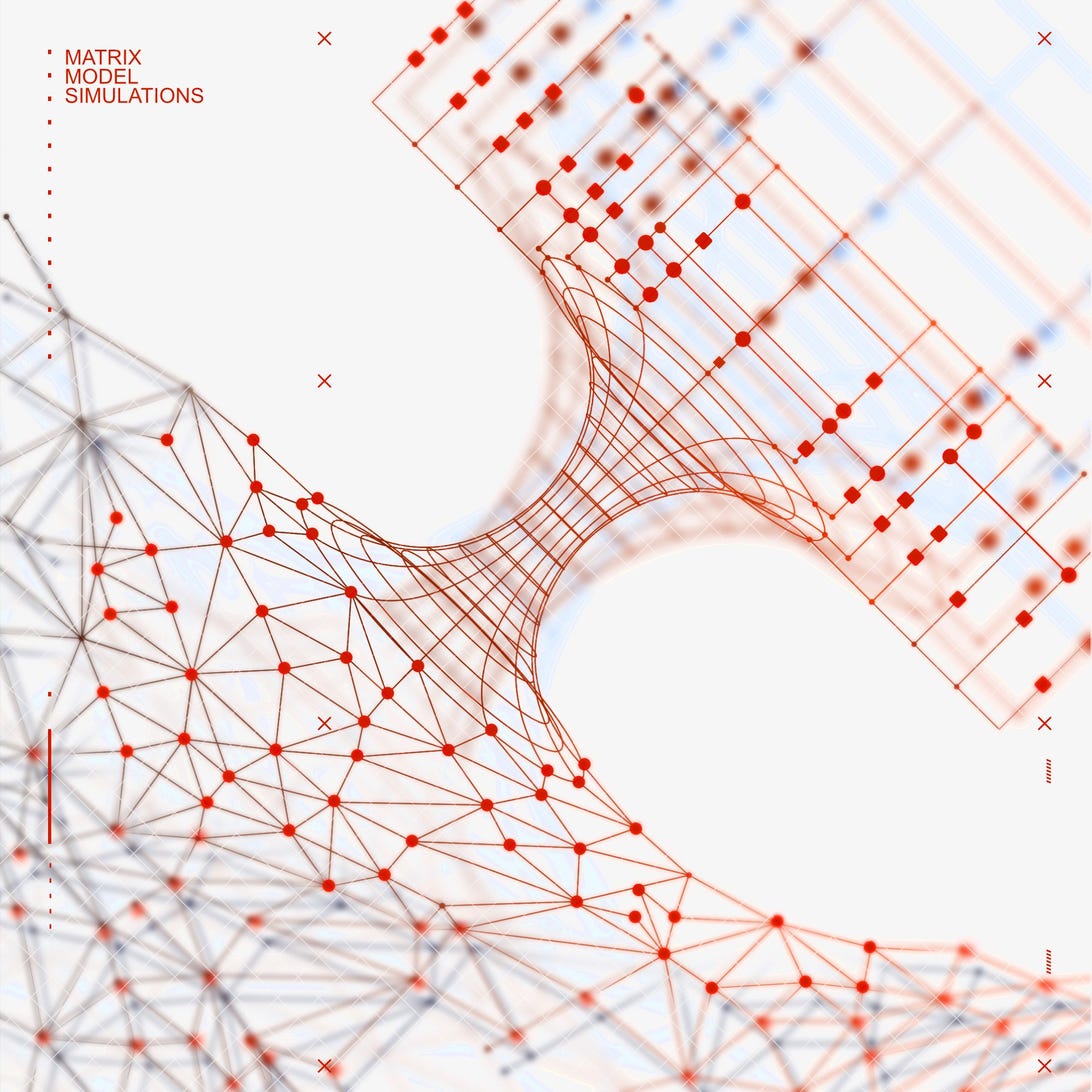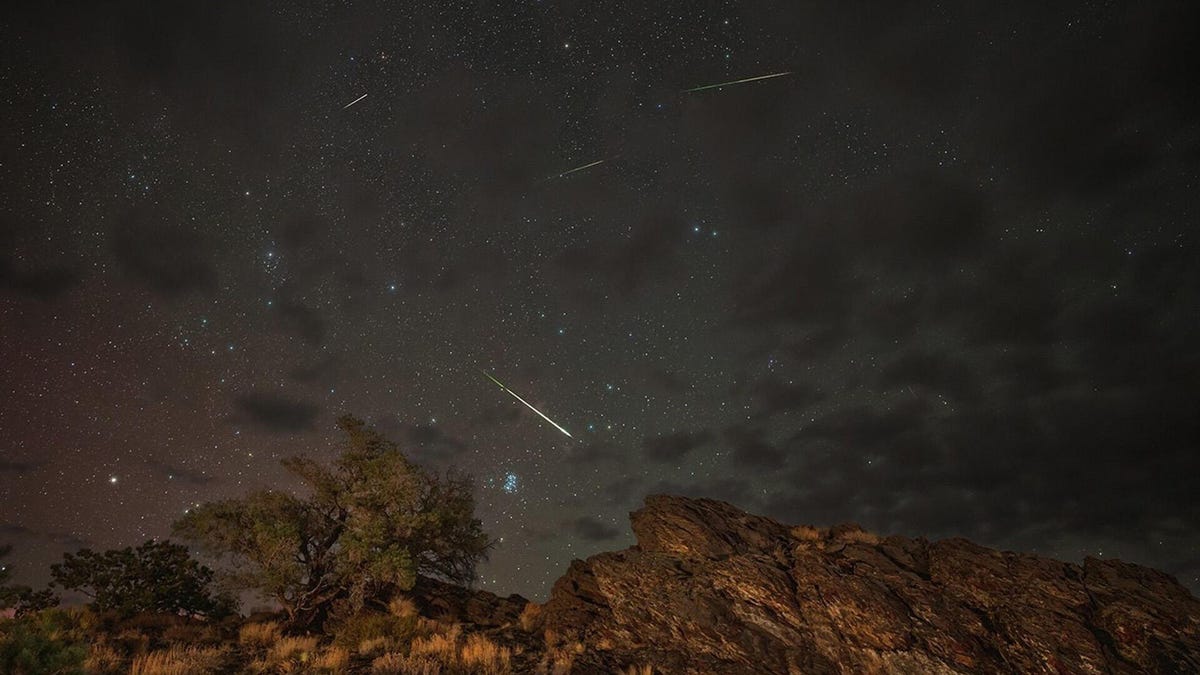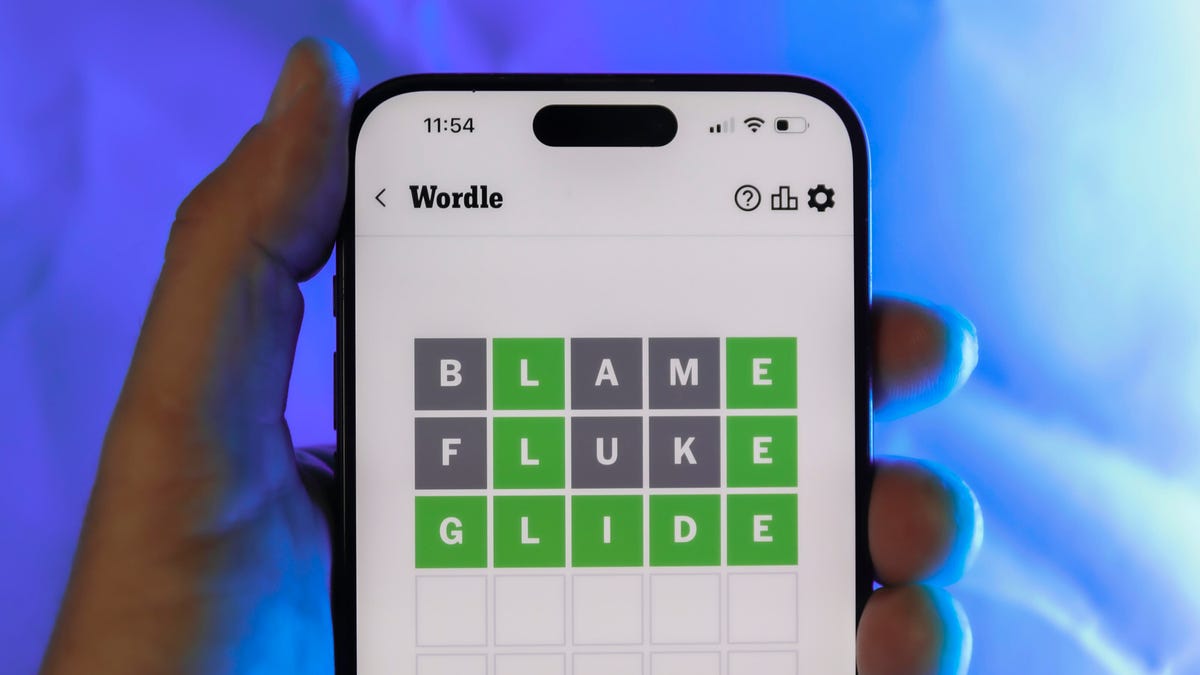Technologies
If The Universe Is A Hologram, We May Soon Gaze Into A Black Hole
A mind-bending theory called holographic duality could lead us into the universe’s deepest, darkest voids.

If you fell into a black hole, your journey might look something like this.
First, you’d stare into the rich, red event horizon of the abyss. Beyond this barrier, light cannot escape. As you get closer, your body would stretch out like chewing gum until it spaghettifies into the void. If you’re still conscious at this point, you’d peer out the entrance and watch a warped universe grow smaller by the second. That wouldn’t be your universe anymore. The black hole would be.
In all probability, though, you’d quickly be ripped to shreds.
Because of this absolutely horrifying disaster, we’ll likely never receive firsthand evidence of what lies within these cosmic mysteries. But in a paper published this month in the journal PRX Quantum, scientists are working toward the next best thing. They developed computing algorithms to help solve a mind-bending theory in physics called «holographic duality.»
In a nutshell, holographic duality suggests that the three-dimensional universe, like space inside black holes, is mathematically strung to the two-dimensional universe, like particle planes and magnetic fields. It basically presents the fabric of spacetime as a 3D hologram «projected» by 2D webs.
I know what you’re thinking. No, this wouldn’t be like the Star Trek holodeck. Unlike classic sci-fi holograms projected by light from a screen, holographic duality is bound by pure mathematics.
«It has not been proven formally, under the point of view of rigorous mathematics, but we know many examples where this duality actually works,» says lead author Enrico Rinaldi, a research scientist at the University of Michigan, based in Tokyo and hosted by the Riken Center for Quantum Computing and the Theoretical Quantum Physics Laboratory.
If holographic duality truly dictates the universe, scientists wouldn’t have to go inside a black hole to take a picture of it. Instead, they could study easy-to-handle 2D space around the beast, then extrapolate the 3D architecture lurking inside. «It is often the case that things difficult to compute on one side are easy to compute on the other side,» Rinaldi says. «That is why this duality is very important and useful.»
He compares the idea to having a dictionary where you can look up a word on one page and find its meaning on another. We just need some sort of index to bridge the 2D space-words with their 3D space-definitions — aka, the mathematical connection. And that’s precisely what Rinaldi’s algorithms are poised to do.
However, before we can use them to unlock the inside of a black hole, there are several, pretty trippy, steps to take. «The duality, as it is right now, applies to a specific spacetime, which is different from the spacetime of our universe,» Rinaldi says.
In other words, holographic duality is confined to a sort of alternate, theoretical world that scientists use as a sandbox.
A spacetime playground
1916 was a big year for physics. Albert Einstein had published the first of many papers that would forever alter the field: a holy grail chronicle of general relativity. Since then, the theory has earned a reputation for being unbreakable. I could go on forever about its spectacular consequences, but here’s the important part for holographic duality.
Suppose you have a trampoline and drop a soccer ball into it. The flat surface will morph inward, depending on where the ball settles. Now, add a tiny marble to the scene. It’ll fall along the trampoline’s curve and nestle next to the soccer ball.
In this analogy, the marble is you, the soccer ball is Earth and the trampoline is the intangible fabric of space and time — spacetime. According to general relativity, gravity is this «curve» we fall along until we’re planted on the ground.
In our universe — which, per experts, is known as the «de Sitter» universe — spacetime’s curvature is positive. That’s a problem. A positive model isn’t great for math equations, Rinaldi explains, especially when it comes to ultra high-dimensional ones. But there’s an easy fix. Scientists simply calculate stuff in a theoretical universe with negative curvature: the anti de Sitter universe. Then they translate their results back to our realm.
Fast-forward to the late 1960s. String theory is born.
Allowing for simplification, string theory says if you break down atoms, the building blocks of our universe, into elementary particles, then pulverize those into even smaller specks, and so on, you’ll eventually get to infinitesimal vibrating «strings.»
Presumably, these strings make up all we know: particles, fields, spacetime. If string theory is true, even you and I are made up of the wiggling bits. That’s why this concept is such a big deal. It might well be the closest we’ve gotten to a theory of everything. On the flip side, however, some physicists consider string theory a dead end because we still haven’t found concrete evidence for its premises.
But regardless, string theory requires unfathomable 11-dimension equations — as you might’ve guessed, that means it’s rooted in the anti de Sitter universe. And per Rinaldi, holographic duality relies on string theory. Thus, it’s also rooted in the anti de Sitter universe.
«Black holes we can investigate right now, with this duality, are not the same black holes that we imagine being out there,» Rinaldi says. «These black holes are a sort of mathematical playground that we can use to formulate this duality and test it.»
Simply put: In this mathematically ideal universe, Rinaldi is observing theoretical black holes to understand holographic duality. It’s like playing a game in tutorial mode before the real level starts. Our universe.
Getting to that level, though, is the crux of this whole procedure. «If we can do it for anti de Sitter,» Rinaldi says, «then we should be doing it for de Sitter.»
«The final goal is still to be able to describe gravity and black holes in our universe.»
The road into a black hole
OK, here’s where it all comes together.
First, a quick recap: Holographic duality can show us what’s inside a black hole because it suggests the 2D universe is connected to the 3D universe via mathematics. We just have to construct an index to bridge the two dimensions. But holographic duality is based on string theory. So, first, we have to make the index’s blueprints in our sandbox universe — the theoretical, anti de Sitter universe.
How do we make the blueprints? Well, Rinaldi says, start with the easier side. That’s the 2D half. But even though this side hurts less to think about, it isn’t that simple; we still need strong numerical methods to analyze it. «That’s what we’re doing,» Rinaldi says. «The numerical part.»
Think of the universe as a blanket knitted by strings that have a bunch of points. Rinaldi’s algorithms use quantum computing and deep learning to help calculate where these points are on the blanket and how they’re attached to each other. The goal is to sort of draw out the «strings» of string theory, then put them all together, like cosmic connect-the-dots.
However, the researchers are still in the proof-of-principle stage. They solved a few prototype points with their method, but these points don’t really represent anything. In the future, though, Rinaldi says the method can scale up to study complex points really present on anti de Sitter strings, including those relevant to anti de Sitter black holes.
Then, we’ll be on our way to making the anti de Sitter 2D-to-3D index that’ll reveal the insides of these theoretical black holes.
Then, if the index is precise enough, it can be translated to our true-to-the-bone, observable universe.
Then… we can use the final index to learn about the threatening insides of real, de Sitter black holes from the comfort of our homes and tucked away from terror.
A new theory of everything?
When you think about the steps Rinaldi and tons of other researchers are taking to realize the insides of a black hole — study prototype theoretical universe strings, scale up to learn about the full theoretical universe’s geometry, zero in on theoretical black holes, take all of that and filter the real universe through it, and probably more we can’t even comprehend — a jarring question might be… why?
Why does this all matter?
«We think we are very close to explaining the information paradox of black holes,» Rinaldi says. «If information goes inside a black hole, general relativity says, OK, whatever goes in is gone forever.»
But quantum mechanics, the other founding principle of our universe, says you cannot lose information. It says information is always maintained. Perhaps it can change, transform or adapt, but it cannot go away. So what’s happening to the information plunging into these massive space-borne voids?
«Stephen Hawking came up with this idea of the evaporation of a black hole and said ‘Look, actually there is stuff coming out of a black hole, it’s just slowly coming out’,» Rinaldi says.
But even those bits coming out don’t look like what went in. Stuff still seems lost in the process. «This is a very, very big problem in physics,» Rinaldi says. «And people are using the duality to understand that paradox.» If we can understand what’s inside, then maybe we can prove so-called lost information is actually, well, inside.
«Maybe it’s not lost, it’s just in a different configuration. It’s not particles anymore; it’s not spacetime anymore; it’s something else.»
Technologies
Quadrantids Is a Short but Sweet Meteor Shower Just After New Year’s. How to See It
This meteor shower has one of the most active peaks, but it doesn’t last for very long.

The Quadrantids has the potential to be one of the most active meteor showers of the year, and skygazers won’t have long to wait to see it. The annual shower is predicted to reach maximum intensity on Jan. 3. And with a display that can rival Perseids, Quadrantids could be worth braving the cold to see it.
Don’t miss any of our unbiased tech content and lab-based reviews. Add CNET as a preferred Google source.
The show officially begins on Dec. 28 and lasts until Jan. 12, according to the American Meteor Society. Quadrantids is scheduled to peak on Jan. 2-3, when it may produce upwards of 125 meteors per hour. This matches Perseids and other larger meteor showers on a per-hour rate, but Quadrantids also has one of the shortest peaks at just 6 hours, so it rarely produces as many meteors overall as the other big ones.
The meteor shower comes to Earth courtesy of the 2003 EH1 asteroid, which is notable because most meteor showers are fed from comets, not asteroids. Per NASA, 2003 EH1 is a near-Earth asteroid that orbits the sun once every five and a half years. Science posits that 2003 EH1 was a comet in a past life, but too many trips around the sun stripped it of its ice, leaving only its rocky core. The Earth runs through EH1’s orbital debris every January, which results in the Quadrantids meteor shower.
How and where to see Quadrantids
Quadrantids is named for the constellation where its meteors appear to originate, a point known as the radiant. This presents another oddity, as the shower originates from the constellation Quadrans Muralis. This constellation ceased to be recognized as an official constellation in the 1920s and isn’t available on most publicly accessible sky maps.
For the modern skygazer, you’ll instead need to find the Bootes and Draco constellations, both of which contain stars that were once a part of the Quadrans Muralis. Draco will be easier to find after sunset on the evening of Jan. 2, and will be just above the horizon in the northern sky. Bootes orbits around Draco, but will remain under the horizon until just after 1 a.m. local time in the northeastern sky. From that point forward, both will sit in the northeastern part of the sky until sunrise. You’ll want to point your chair in that direction and stay there to see meteors.
As the American Meteor Society notes, Quadrantids has a short but active peak, lasting around 6 hours. The peak is expected to start around 4 p.m. ET and last well into the evening. NASA predicts the meteor shower to start one day later on Jan. 3-4, so if you don’t see any on the evening of Jan. 2, try again on Jan. 3.
To get the best results, the standard space viewing tips apply. You’ll want to get as far away from the city and suburbs as possible to reduce light pollution. Since it’ll be so cold outside, dress warmly and abstain from alcoholic beverages, as they can affect your body temperature. You won’t need any binoculars or telescopes, and the reduced field of view may actually impact your ability to see meteors.
The bad news is that either way, the Quadrantids meteor shower coincides almost perfectly with January’s Wolf Moon, which also happens to be a supermoon. This will introduce quite a lot of light pollution, which will likely drown out all but the brightest meteors. So, while it may have a peak of over 100 meteors per hour, both NASA and the AMS agree that the more realistic expectation is 10 or so bright meteors per hour.
Technologies
Today’s Wordle Hints, Answer and Help for Dec. 24, #1649
Here are hints and the answer for today’s Wordle for Dec. 24, No. 1,649.

Looking for the most recent Wordle answer? Click here for today’s Wordle hints, as well as our daily answers and hints for The New York Times Mini Crossword, Connections, Connections: Sports Edition and Strands puzzles.
Today’s Wordle puzzle is a little tricky, with a double letter that could confuse players. If you need a new starter word, check out our list of which letters show up the most in English words. If you need hints and the answer, read on.
Read more: New Study Reveals Wordle’s Top 10 Toughest Words of 2025
Today’s Wordle hints
Before we show you today’s Wordle answer, we’ll give you some hints. If you don’t want a spoiler, look away now.
Wordle hint No. 1: Repeats
Today’s Wordle answer has one repeated letter.
Wordle hint No. 2: Vowels
Today’s Wordle answer has one vowel, but it’s the repeated letter, so you’ll see it twice.
Wordle hint No. 3: First letter
Today’s Wordle answer begins with S.
Wordle hint No. 4: Last letter
Today’s Wordle answer ends with L.
Wordle hint No. 5: Meaning
Today’s Wordle answer can refer to a cylindrical device upon which thread is wound.
TODAY’S WORDLE ANSWER
Today’s Wordle answer is SPOOL.
Yesterday’s Wordle answer
Yesterday’s Wordle answer, Dec. 23, No. 1648 was GLINT.
Recent Wordle answers
Dec. 19, No. 1644: MYRRH
Dec. 20, No. 1645: WHITE
Dec. 21, No. 1646: QUILT
Dec. 22, No. 1647: CONCH
Don’t miss any of our unbiased tech content and lab-based reviews. Add CNET as a preferred Google source.
Technologies
Today’s NYT Connections: Sports Edition Hints and Answers for Dec. 24, #457
Here are hints and the answers for the NYT Connections: Sports Edition puzzle for Dec. 24, No. 457.

Looking for the most recent regular Connections answers? Click here for today’s Connections hints, as well as our daily answers and hints for The New York Times Mini Crossword, Wordle and Strands puzzles.
Today’s Connections: Sports Edition is a bit of a toughie, with a lot of proper nouns included. If you’re struggling but still want to solve it, read on for hints and the answers.
Connections: Sports Edition is published by The Athletic, the subscription-based sports journalism site owned by The Times. It doesn’t appear in the NYT Games app, but it does in The Athletic’s own app. Or you can play it for free online.
Read more: NYT Connections: Sports Edition Puzzle Comes Out of Beta
Hints for today’s Connections: Sports Edition groups
Here are four hints for the groupings in today’s Connections: Sports Edition puzzle, ranked from the easiest yellow group to the tough (and sometimes bizarre) purple group.
Yellow group hint: What separates two entities.
Green group hint: Head to the mountains.
Blue group hint: Mitt makers.
Purple group hint: Kick it.
Answers for today’s Connections: Sports Edition groups
Yellow group: Gap between two opponents.
Green group: A skier’s needs.
Blue group: Baseball glove manufacturers.
Purple group: NFL punters.
Read more: Wordle Cheat Sheet: Here Are the Most Popular Letters Used in English Words
What are today’s Connections: Sports Edition answers?
The yellow words in today’s Connections
The theme is gap between two opponents. The four answers are advantage, edge, lead and margin.
The green words in today’s Connections
The theme is a skier’s needs. The four answers are boots, poles, skis and snow.
The blue words in today’s Connections
The theme is baseball glove manufacturers. The four answers are Mizuno, Nike, Rawlings and Wilson.
The purple words in today’s Connections
The theme is NFL punters. The four answers are Anger, Haack, Stout and Way.
Don’t miss any of our unbiased tech content and lab-based reviews. Add CNET as a preferred Google source.
-

 Technologies3 года ago
Technologies3 года agoTech Companies Need to Be Held Accountable for Security, Experts Say
-

 Technologies3 года ago
Technologies3 года agoBest Handheld Game Console in 2023
-

 Technologies3 года ago
Technologies3 года agoTighten Up Your VR Game With the Best Head Straps for Quest 2
-

 Technologies4 года ago
Technologies4 года agoBlack Friday 2021: The best deals on TVs, headphones, kitchenware, and more
-

 Technologies4 года ago
Technologies4 года agoVerum, Wickr and Threema: next generation secured messengers
-

 Technologies4 года ago
Technologies4 года agoGoogle to require vaccinations as Silicon Valley rethinks return-to-office policies
-

 Technologies4 года ago
Technologies4 года agoOlivia Harlan Dekker for Verum Messenger
-

 Technologies4 года ago
Technologies4 года agoiPhone 13 event: How to watch Apple’s big announcement tomorrow
